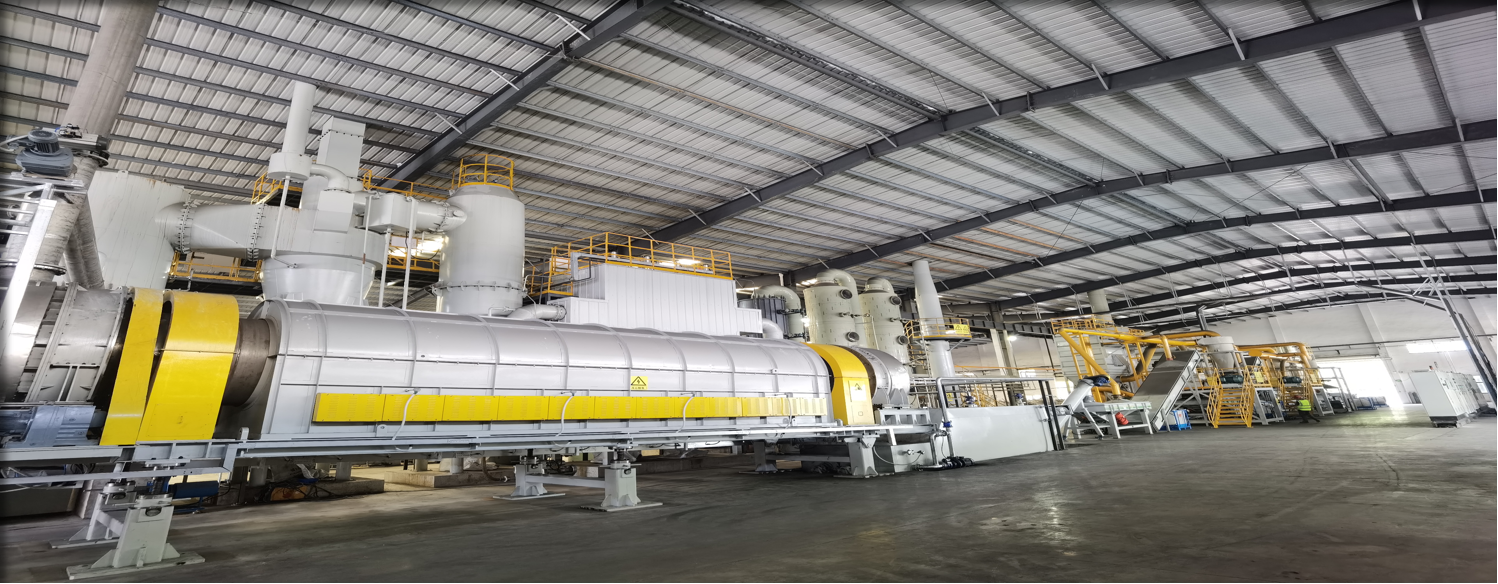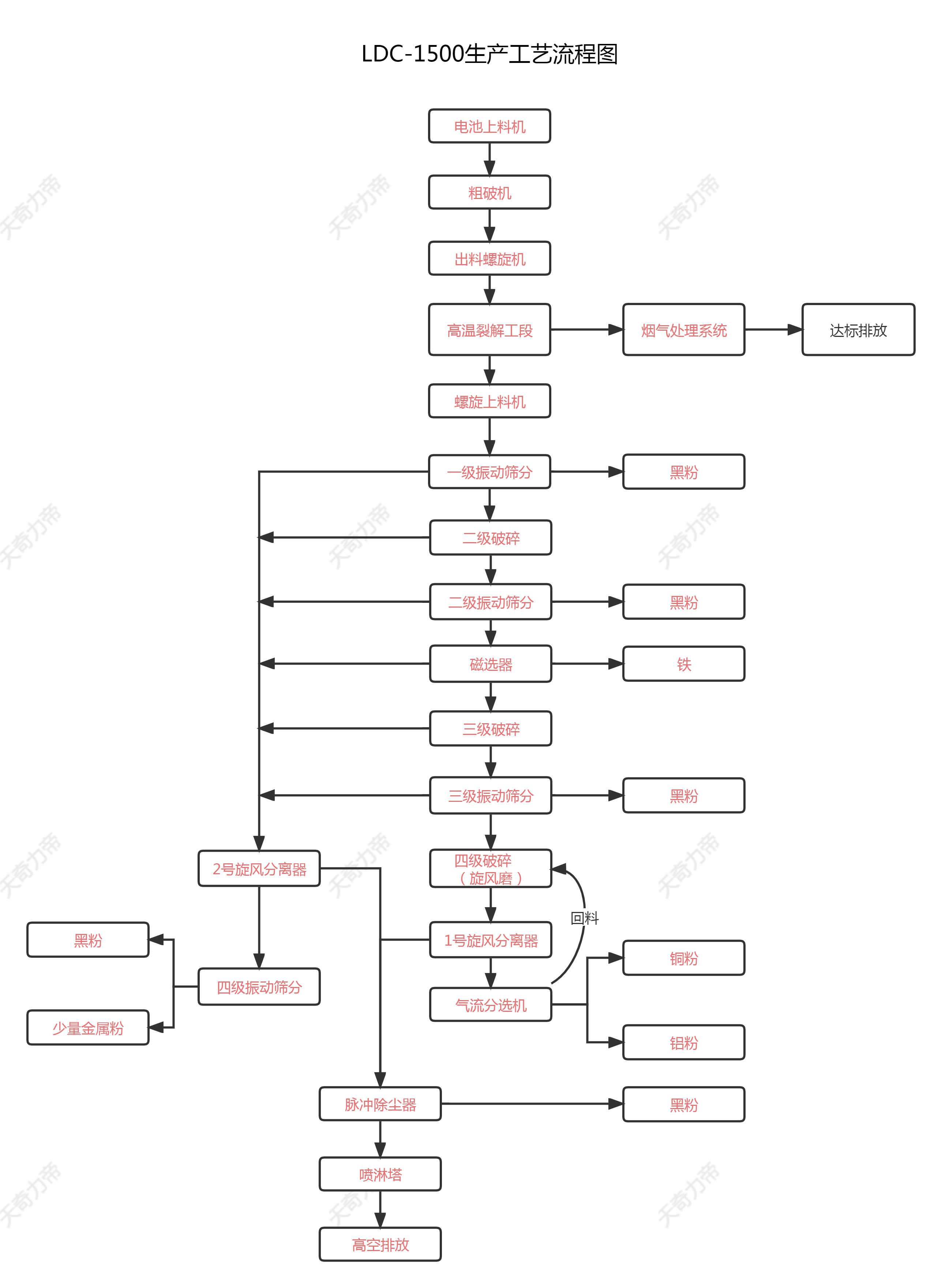

1. The waste lithium battery recycling and sorting equipment includes: primary crusher, screw conveyor, high-temperature cracking furnace, secondary crusher, tertiary crusher, vibrating sorter, quaternary crusher, air flow sorter, pulse dust collector, flue gas treatment system, etc. It can provide a complete solution for the fine recycling and sorting of retired power lithium batteries, producing recyclable metal powders (copper foil, aluminum foil) and electrode powders (carbon powder, lithium cobalt oxide powder, lithium iron phosphate, etc.). Designed capacity: 1500kg/h.
2. Provide a complete solution according to the customer's battery material type (lithium battery positive and negative electrode sheets, laminates, ternary lithium batteries, lithium iron phosphate batteries, etc.) for retired power lithium batteries.
LDC-1500 Waste Lithium Battery Recycling and Processing Line Process Flow Chart:

The process flow overview of LDC-1500 waste lithium battery recycling and disposal line:
The system engineering can be divided into four main process steps: battery module pre-treatment, rotary kiln anaerobic pyrolysis, crushing and sorting, and flue gas environmental treatment.
Specific process flow overview:
1. The crushed material is manually fed into the ton bag feeding machine and conveyed to the rotary kiln feeding machine by a screw conveyor and a discharge conveyor. The battery modules and electrode materials are manually placed on the battery module feeding chain plate and then shredded by a single-axis shredder. The shredded material is then conveyed to the rotary kiln feeding machine by a discharge conveyor.
2. The rotary kiln feeding machine feeds the material into the rotary kiln, where anaerobic pyrolysis is performed to remove the separator paper and electrolyte. The material is then discharged to the screening feeding machine after the cooling section.
3. The screening feeding machine conveys the material to the primary vibrating screening machine.
4. The primary vibrating screening machine separates most of the black powder and conveys the upper layer material to the secondary crusher by the secondary crushing feeding machine.
5. The material crushed by the secondary crusher is screened by the secondary screening machine to separate some black powder, and the upper layer material is conveyed to the tertiary crusher by the tertiary crushing feeding machine (during the conveying process, iron materials are sorted out).
6. The material crushed by the tertiary crusher is screened by the tertiary screening machine to separate some black powder, and the upper layer material is conveyed to the quaternary crusher by the quaternary crushing feeding machine for quaternary crushing.
7. The material after quaternary crushing enters the air flow separator through the cyclone separator to separate copper powder and aluminum powder. The coarse material that cannot be separated is further returned to the quaternary crusher for repeated crushing.
8. The materials collected by various dust suction ports are deposited at the bottom through the cyclone separator, and the black powder metal powder is recovered by the quaternary vibrating screening machine as the final step of screening and recovery. The internal air flow and cyclone separator are filtered and recovered through the bag filter. The exhaust gas is treated through a spray tower for environmental emission.
Design features:
Modular design:
1. Modular design allows for independent design, manufacturing, debugging, and updating of individual modules.
2. Good interchangeability, standardized structure and size of module interfaces make it easy to achieve module interchangeability, thereby meeting the needs of different process flows.
Centralized control:Increase labor productivity, control product quality stability, reduce manufacturing costs, and replace manual operations in hazardous or dangerous environments.
Diversification of the production process:The process layout can be reasonably matched according to the battery category and depth of processing requirements of the user.
Green workshop:Intelligent, green workshop with full sealing to prevent leaks and achieve emission standards for exhaust gases.
Automated Operation Video of Lithium Battery Project:

 0086-717-6731227
0086-717-6731227
 The 2nd Avenue Longxi Road, Xiling Economic
The 2nd Avenue Longxi Road, Xiling Economic
Development Zone in Yichang City, Hubei Province
Technical Support:![]()